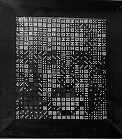What is
Pointillism?

Pointillism is a form of art which uses multiple small dots to create a picture. These dots are placed in patterns to create an image which is recognizable. Placing the dots in a color pattern, and placing them in more dense or less dense patterns create the image. When standing close to a picture that is created by pointillism, all the viewer can observe is an array of dots. When the viewer steps back, the image can become more and more recognizable. This occurs, because of the way in which the human eye and brain work. When the eye sees many dots close up, each dot can be recognized because the eye can focus closely on each separate dot, and space between the dots. When the viewer backs up, their eyes cannot focus as clearly on each dot, so the dots appear to blend together. The blending together creates what the viewer sees as new forms and shades of color. Your brain recognizes the picture because when the brain sees images it stores them in your memory, so later, when your brain perceives a similar image to something in your memory, the image is processed in the brain using that context and recognized as a particular image.
Pointillism is an offshoot of Impressionism, and is usually classified as a form of Post-Impressionism. Pointillism was first created (and used frequently) by the French artist Georges Seurat. Seurat was a leader in the Neo-Impressionist movement of the late 19th century. Seurat was an example of a scientist and artist. He studied color theories and the effects of different linear structures. Using these different studies and theories, Seurat created many images using the technique of Pointillism.
------------------
Sources:
http://nths.newtrier.k12.il.us/academics/math/Connections/perception/ptphys1.htm
http://www.reachingcriticalwill.org/nwc/mon1steph.html
http://www.ibiblio.org/wm/paint/auth/seurat/
------------------